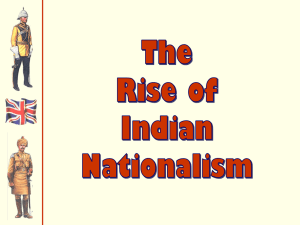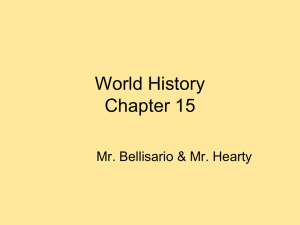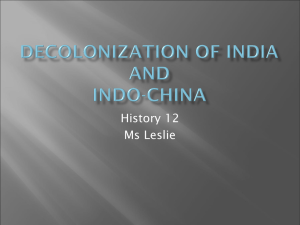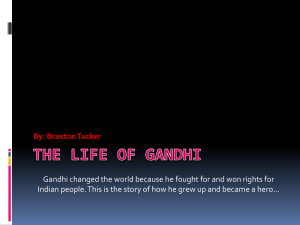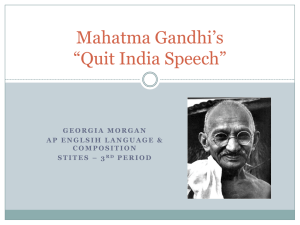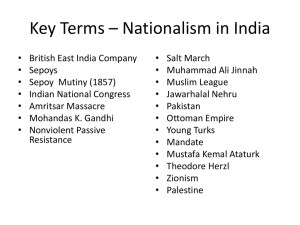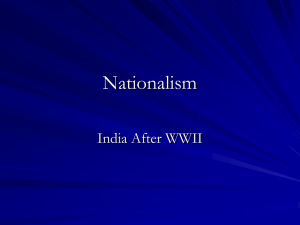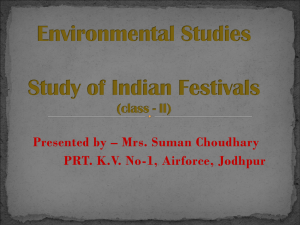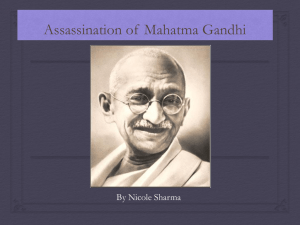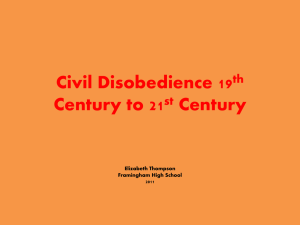The Round Table Conferences
advertisement
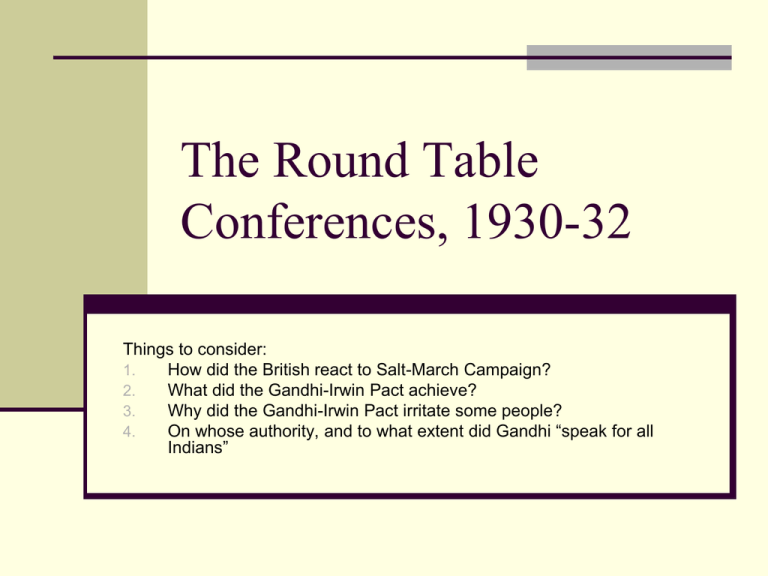
The Round Table Conferences, 1930-32 Things to consider: 1. How did the British react to Salt-March Campaign? 2. What did the Gandhi-Irwin Pact achieve? 3. Why did the Gandhi-Irwin Pact irritate some people? 4. On whose authority, and to what extent did Gandhi “speak for all Indians” The relationship between Britain and India: what does this cartoon, which was published in Punch Magazine in January 1931infer? The Round Table Conference Three sessions: The First sat from November 1930 to January 1931 It was chaired by P.M. Ramsey MacDonald (Labour) The Second sat from September to December 1931 By this time the Labour government had fallen and had been replaced by a Conservative dominated National Government, led by Ramsey MacDonald. The conference was supervised by the new Secretary of State, Sir Samuel Hoare (Conservative) The Third sat from November to December 1932 It was supervised by Samuel Hoare Viceroy of India, Lord Irwin Following the Simon Commission and Congress’s demand for Swaraj (self rule) the viceroy: Announced a round-table conference, 31st January 1929 It would settle India’s constitutional future The First Round-Table Conference assembled in London on 12th November 1930 It started with 89 representatives: 16 from the main British political parties 16 Indian Princes 57 nominees of the viceroy, which included Muslims, Sikhs and Indian Christians Also included were a number of representatives of the lowest Indian caste (dalits / untouchables) However, Congress was not represented and, as Gandhi was in Yeravda prison he could not attend! The Times summed up the opinion of many: “No Indian delegation without Gandhi or the two Nehrus could possibly be looked upon as representation” Discuss Furthermore; whilst Gandhi was in prison he was a focus for protestors and of protest – so if by imprisoning Gandhi the British thought to neutralise him – they were mistaken! Lord Irwin released Gandhi from prison so that negotiations could take place – they met face to face in February 1931 Their ‘frank and open discussions’ led to The GandhiIrwin Pact, which was signed on 5th March 1931 The Gandhi-Irwin Pact After negotiations; Gandhi agreed that: Congress’s civildisobedience campaign would end He would continue to peacefully support Indian goods whilst not threatening the sale of British products Gandhi would participate in the 2nd Round Table conference in London If Gandhi called off the civildisobedience campaign Irwin promised: Future political changes would be in the interests of India To release from gaol supporters not guilty of violent crimes 19,000 were released Confiscated property was returned to its owners Some emergency restrictions were relaxed Reaction to the Gandhi-Irwin Pact Many Indians were unhappy and felt betrayed by Gandhi Why? Congress approved the Gandhi-Irwin Pact but there was a lot of criticism that Gandhi had abandoned another popular campaign that was likely to achieve their goal of Swaraj Compare with the abandonment of non-cooperation in 1922 In Britain some conservatives accused Irwin of giving too much away and in doing so he was weakening the Empire Lord Willingdon was annoyed that Gandhi had been treated respectfully by Irwin, and thus awarded credibility There were expectations and assumptions on all sides W.S. Churchill, who later resigned from the opposition front-bench to actively campaign against Congress, made his feelings clear by declaring that it was “alarming and also nauseating to see Mr Gandhi, a seditious Middle Temple lawyer, now posing as a fakir of a type well-known in the East, striding halfnaked up the steps of the vice-regal palace while he is still organising and conducting a defiant campaign of civil disobedience to parley on equal terms with [the] representative of the KingEmperor. Such a spectacle can only increase the unrest in India, and the danger to which white people there are exposed” Winston Spencer Churchill, 1874-1965 Grew up surrounded by Imperialist beliefs in the superiority of white people and Christian values With 50 other Tory MPs and a few Lancashire Cotton kings (Industrialists) he formed the Indian Defence League He gave passionate speeches about the “proper and permanent subjugation” of Indians and their “total unsuitability” to engage in democracy Discuss… The second session of the Round Table Conference Opened on 7th September 1931 Gandhi represented Congress He was mandated to demand purna swaraj and make NO concessions! Gandhi questioned the right of his fellow Indians to be at the conference table as he alone spoke for fall India Regardless of what Gandhi thought he was doing, his attitude provoked anger from other representatives (see over ) Debate: On whose authority, and to what extent did Gandhi “speak for all Indians” The second round table session ended without agreement Consequently, on August 4th 1932 the British government announced the Communal Award, which was a separate representation for “recognised minorities” and for the “scheduled castes” (dalits/untouchables) Gandhi demonstrated his opposition to this by going on an indefinite fast He believed that Congress, or he personally, was the best protector of the dalits The Poona Pact later attempted to resolve disagreement. Meanwhile: Whilst Gandhi was in London the brutal and repressive measures by which Britain ruled India persisted Ordinary Indians continued to suffer brutality at the hands of those who claimed authority Viceroy, Lord Irwin was replaced by Lord Willingdon The new viceroy had Gandhi arrested within a week of his return Lord Willingdon, 1866 -1941 Spent many years in India Governor of Bombay, 1913-18 Governor of Madras 1918-24: during Moplah riots Viceroy of India 193136 Anonymous cartoon c. 1931/2: analyse and discuss Lord Willingdon’s imperialist views made clear Telegram from Lord Willingdon’s office to Gandhi, December 1931". . . His Excellency feels bound to emphasize that he will not be prepared to discuss with you the measures which the Government of India, with the full approval of His Majesty's Government, have found it necessary to adopt in Bengal, the United Provinces and the North-west Frontier Province. . . ." Discuss Congress requested discussions with the new viceroy, which he ignored 1st June 1932 Congress declared that In the event of a satisfactory response not forthcoming from the viceroy, the Working Committee calls upon the nation to resume civil disobedience, including the non-payment of taxes Government responded by granting itself emergency powers: Outlawed machinery of government by which Congress operated Local branches, committees and offices C. 100,000 people were placed under immediate arrest Gandhi advised Congress to end civil disobedience and he asked the British to release the prisoners – both parties refused The third session of the Round Table Conference Any chance of agreement was lost due to a variety of reasons Ramsey MacDonald’s reputation was in tatters He had lost the support of the Labour party His continued premiership was in question Gandhi and many others did not attend The Government of India Act 1933: British government published a white-paper on the constitution of India There was significant opposition White-paper: a political document (Bill) that sets out proposals that lead to legislation (Act) Conservative imperialists were outraged and demanded “no surrender” Radicals believed it did not go far enough The bill gained royal assent on August 2nd 1935 and thus became the Government of India Act and came into effect in 1937 Main provisions of the Act Expand electorate to 35 million people, c. 10% of the Indian population (thus not a full franchise) Give provincial control to India including those that had been “reserved” under previous reforms Creation of provincial governments with legislative powers No change in central administration Responsibility for defence and foreign policy retained by viceroy Emergency powers reserved and held by central government Reactions & Elections A bit of an anti-climax many Indians were very disappointed with this outcome Congress was divided: Some wanted to oppose the Act in principle Others wanted to use the Act to squeeze out of it as much power as possible 1937 elections excited the political situation Created a sense of ‘success’ Question: Use Sources 1, 2 &3 and your own knowledge Do you agree with the view that Gandhi’s campaign methods in the 1930’s were effective? Explain your answer using Sources 1, 2 & 3 and your own knowledge. 40 marks
